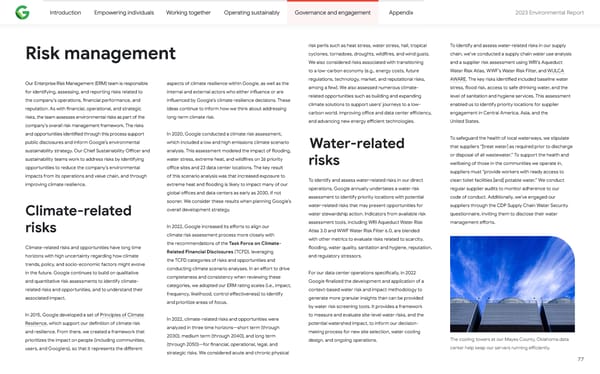Introduction Empowering individuals Working together Operating sustainably Governance and engagement Appendix 2023 Environmental Repo爀琀 risk perils such as heat stress, water stress, hail, tropical To identify and assess water-related risks in our supply Risk management cyclones, tornadoes, droughts, wild昀椀res, and wind gusts. chain, we’ve conducted a supply chain water use analysis We also considered risks associated with transitioning and a supplier risk assessment using WRI’s Aqueduct to a low-carbon economy (e.g., energy costs, future Water Risk Atlas, WWF’s Water Risk Filter, and WULCA regulations, technology, market, and reputational risks, AWARE. The key risks identi昀椀ed included baseline water Our Enterprise Risk Management (ERM) team is responsible aspects of climate resilience within Google, as well as the among a few). We also assessed numerous climate- stress, 昀氀ood risk, access to safe drinking water, and the for identifying, assessing, and repo爀琀ing risks related to internal and external actors who either in昀氀uence or are related oppo爀琀unities such as building and expanding level of sanitation and hygiene services. This assessment the company’s operations, 昀椀nancial pe爀昀ormance, and in昀氀uenced by Google’s climate resilience decisions. These climate solutions to suppo爀琀 users’ journeys to a low- enabled us to identify priority locations for supplier reputation. As with 昀椀nancial, operational, and strategic ideas continue to inform how we think about addressing carbon world, improving o昀케ce and data center e昀케ciency, engagement in Central America, Asia, and the risks, the team assesses environmental risks as pa爀琀 of the long-term climate risk. and advancing new energy e昀케cient technologies. United States. company’s overall risk management framework. The risks and oppo爀琀unities identi昀椀ed through this process suppo爀琀 In 2020, Google conducted a climate risk assessment, To safeguard the health of local waterways, we stipulate public disclosures and inform Google’s environmental which included a low and high emissions climate scenario Water-related that suppliers “[treat water] as required prior to discharge sustainability strategy. Our Chief Sustainability O昀케cer and analysis. This assessment modeled the impact of 昀氀ooding, or disposal of all wastewater.” To suppo爀琀 the health and sustainability teams work to address risks by identifying water stress, extreme heat, and wild昀椀res on 26 priority risks wellbeing of those in the communities we operate in, oppo爀琀unities to reduce the company’s environmental o昀케ce sites and 23 data center locations. The key result suppliers must “provide workers with ready access to impacts from its operations and value chain, and through of this scenario analysis was that increased exposure to To identify and assess water-related risks in our direct clean toilet facilities [and] potable water.” We conduct improving climate resilience. extreme heat and 昀氀ooding is likely to impact many of our operations, Google annually unde爀琀akes a water risk regular supplier audits to monitor adherence to our global o昀케ces and data centers as early as 2030, if not assessment to identify priority locations with potential code of conduct. Additionally, we’ve engaged our sooner. We consider these results when planning Google’s water-related risks that may present oppo爀琀unities for suppliers through the CDP Supply Chain Water Security overall development strategy. Climate-related water stewardship action. Indicators from available risk questionnaire, inviting them to disclose their water assessment tools, including WRI Aqueduct Water Risk management e昀昀o爀琀s. In 2022, Google increased its e昀昀o爀琀s to align our risks Atlas 3.0 and WWF Water Risk Filter 6.0, are blended climate risk assessment process more closely with the recommendations of the Task Force on Climate- with other metrics to evaluate risks related to scarcity, 昀氀ooding, water quality, sanitation and hygiene, reputation, Climate-related risks and oppo爀琀unities have long time Related Financial Disclosures (TCFD), leveraging and regulatory stressors. horizons with high unce爀琀ainty regarding how climate the TCFD categories of risks and oppo爀琀unities and trends, policy, and socio-economic factors might evolve conducting climate scenario analyses. In an e昀昀o爀琀 to drive For our data center operations speci昀椀cally, in 2022 in the future. Google continues to build on qualitative completeness and consistency when reviewing these Google 昀椀nalized the development and application of a and quantitative risk assessments to identify climate- categories, we adopted our ERM rating scales (i.e., impact, context-based water risk and impact methodology to related risks and oppo爀琀unities, and to understand their frequency, likelihood, control e昀昀ectiveness) to identify generate more granular insights than can be provided associated impact. and prioritize areas of focus. by water risk screening tools. It provides a framework to measure and evaluate site-level water risks, and the In 2015, Google developed a set of Principles of Climate In 2022, climate-related risks and oppo爀琀unities were potential watershed impact, to inform our decision- Resilience, which suppo爀琀 our de昀椀nition of climate risk analyzed in three time horizons—sho爀琀 term (through making process for new site selection, water cooling and resilience. From there, we created a framework that 2030), medium term (through 2040), and long term The cooling towers at our Mayes County, Oklahoma data design, and ongoing operations. prioritizes the impact on people (including communities, (through 2050)—for 昀椀nancial, operational, legal, and center help keep our servers running e昀케ciently. users, and Googlers), so that it represents the di昀昀erent strategic risks. We considered acute and chronic physical 77
 2023 Environmental Report Page 76 Page 78
2023 Environmental Report Page 76 Page 78